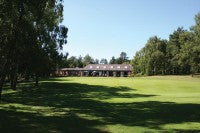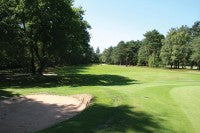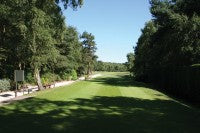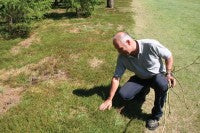And here's to you Mr. Robinson
 Situated just a few miles to the north of the historic market town of King's Lynn at Castle Rising is one of East Anglia's premier golf clubs.
Situated just a few miles to the north of the historic market town of King's Lynn at Castle Rising is one of East Anglia's premier golf clubs.
King's Lynn Golf Club was founded in 1923 and the club moved to its current site in 1975. The 18 hole course was designed by Dave Thomas and Peter Alliss and, at 6609 yards par 72, is a real challenge for even the most accomplished player.
Carved out of the picturesque North West Norfolk pine and silver birch forests, and just down the road from the Royal Sandringham Estate, this sandy, well-drained course compares favourably with some of the finest inland courses in the UK.
 The club has recently employed the services of Colin Robinson LCGI, MSc as Course Manager. Colin, who previously worked at the 36 hole John O'Gaunt Golf Club in Bedfordshire for twelve years, had taken 'a year out' to travel round the world. Fifteen months later he was back and looking for employment.
The club has recently employed the services of Colin Robinson LCGI, MSc as Course Manager. Colin, who previously worked at the 36 hole John O'Gaunt Golf Club in Bedfordshire for twelve years, had taken 'a year out' to travel round the world. Fifteen months later he was back and looking for employment.
When the opportunity to join King's Lynn became available Colin jumped at the chance. "I liked the club's philosophy on golf management" he said. "In addition, it's a challenging opportunity with a lot of potential. There's a hint of Wentworth, a touch of Woking and a sprinkling of Woburn here."
King's Lynn is an inland links course that sits on a rich vein of natural sandy soil, providing the perfect profile for a golf course with free draining greens, tees and fairways. The sheer depth and fineness of the sand certainly helps to act as a perched water table, assisting moisture retention for the native grasses and plants around the course.
"I'm currently taking a number of soil samples from around the course to establish exactly what I have got here" said Colin. "Once I have the results it will help me manage the course more effectively."
"I've set myself a number of targets. In the short term I just need to deliver the course in the best possible condition with the resources that I have inherited. In the longer-term I aim to improve sward composition, reduce fertiliser inputs and encourage finer bent and fescue grasses."
 "As soon as I started, I identified a couple of areas, that were not getting the right treatment , so we purchased a Toro 648 aerator and John Deere ride on triple mower so we can do much more aeration and cut areas that were uncut before."
"As soon as I started, I identified a couple of areas, that were not getting the right treatment , so we purchased a Toro 648 aerator and John Deere ride on triple mower so we can do much more aeration and cut areas that were uncut before."
"What I have got is an experienced team under me. My deputy, Dale Morley, has been here for sixteen years and knows the course inside out. I've also got three other long serving members of staff, Alistair McCoy (30 years) Richard Lepoidevin (23) and Alan Cawston (20). Shaun Carroll is our greenkeeper/mechanic and he's been here for seven years. And, I've recently taken on Matt Goss as an apprentice, he'll be studying for NVQ Level 2."
"We've got over 700 members, many of whom like to start their rounds early in the summer months, so we start our working day at 6.00am to keep ahead of the golfers. Most days we will have mown all the greens, tees and half the fairways, changed the holes and raked the bunkers by 9.30am. Then we have breakfast! We generally finish our day at 2.30pm."
Holes are changed four times a week, on Tuesday, Thursday, Friday and Saturday.
 "The greens are, at present, 60-70% poa, 30-40 % bent with a little bit of fescue, with some greens moving towards a 50/50 split. My aim, over the next few years, is to improve the fescue/bent population with a programme of overseeding and reduced fertiliser inputs. This year I've managed to get nitrogen inputs down below 70 kg/N per Ha, which is a step in the right direction."
"The greens are, at present, 60-70% poa, 30-40 % bent with a little bit of fescue, with some greens moving towards a 50/50 split. My aim, over the next few years, is to improve the fescue/bent population with a programme of overseeding and reduced fertiliser inputs. This year I've managed to get nitrogen inputs down below 70 kg/N per Ha, which is a step in the right direction."
All the greens are raised sand/soil and very free draining. "We feed them monthly with a Scotts 12:4:6 folia feed, plus a programme of PrimoMaxx. I'll also incorporate seaweed extracts and some timely applications of chelated iron to maintain colour, especially through the winter months. And, I use a monthly dose of wetting agents to help control dry patch."
"During the growing season we topdress the greens monthly with a Baileys 70/30 fen soil rootzone, applying about fifteen tonnes in total over the eighteen greens. We verti-drain prior to any topdressing programmes and during the winter months when conditions allow. We also have a SISIS AerAid Javelin and use this once a month throughout the growing season. In August we'll overseed the greens with some bent and fescue grasses."
"The greens are cut to 4mm on a daily basis. For competitions we'll perhaps double cut and roll just to speed them up. In winter they are kept to 6mm."
 "Tees are hollow cored twice a year, in spring and autumn, and we leave the cores on the surface to break down. After a few weeks any debris remaining is boxed off. They are oversown with Bar 6 ryegrass to provide a more hardwearing sward, and fed with granular 10% nitrogen slow release fertliser. I maintain a height of cut around 12-13mm all year round. I'll deep aerate with the verti-drain in October."
"Tees are hollow cored twice a year, in spring and autumn, and we leave the cores on the surface to break down. After a few weeks any debris remaining is boxed off. They are oversown with Bar 6 ryegrass to provide a more hardwearing sward, and fed with granular 10% nitrogen slow release fertliser. I maintain a height of cut around 12-13mm all year round. I'll deep aerate with the verti-drain in October."
"We maintain the fairways at 16mm all year round, they were fed, for a short period, to re-establish some grass cover. Once this was achieved I then reduced the amount of nitrogen to allow the finer grasses to establish. We also vertidrain on a regular basis as and when conditions allow.
"Normal rough is cut weekly at 50mm. Rough containing heather is only cut three times a year at 175 mm. This is a new mowing regime for the heather and it is responding well. I'm hoping to see some stunning colour in autumn."
"Our irrigation system is fairly old. The water is drawn from a borehole and we also have a natural lake on the course that we can draw from. The system is in need of an upgrade. We've already made a start by replacing some of the pop-ups with new John Deere precision heads."
 "Next year I will be proposing to the general committee that we need to dredge the lake and removing part, if not all, of an island to increase its capacity and make it a better feature of the course."
"Next year I will be proposing to the general committee that we need to dredge the lake and removing part, if not all, of an island to increase its capacity and make it a better feature of the course."
"This will be ongoing work until all the old ones are replaced. Next year we will start dredging the lake and removing part, if not all, of an island to increase its capacity and make it a better feature of the course."
"Last winter we were kept busy refurbishing the 11th and 15th tees; both were relevelled and returfed. This winter we will be thinning out some of the trees, opening up areas to allow more light and allowing the remaining trees to develop into better specimens. Air flow around the greens is one of our biggest problems. At the moment it is restricted by the denseness of the woods, so this thinning work is really important. Fusarium has been a real problem and I'm expecting the increased air flow to help resolve that. At the moment it is controlled with preventative spraying which I want to reduce over the coming years. It'll all take time though."
 "As for pests there are not too many to worry about. Some localised worm infestations were suppressed with a dose of Carbendazim, and a four hectare area had to be treated with Merit to control chafer grubs that were a problem last year. However, fingers crossed, they have not been an issue this year."
"As for pests there are not too many to worry about. Some localised worm infestations were suppressed with a dose of Carbendazim, and a four hectare area had to be treated with Merit to control chafer grubs that were a problem last year. However, fingers crossed, they have not been an issue this year."
Colin has recently completed his first year at King's Lynn and I asked him how he was enjoying being 'back in golf' after his rambles? "It's been really good" he responded instantly. "I cannot fault the way I have been treated by the club's management, and how well they, the staff and the members have responded to all my proposals."
"The club do not operate a greens committee system of management. I report directly to the general committee on a monthly basis. Providing an overview of the work carried out on the course during the last month. I also meet John Reynolds (Golf Manager) every day on an informal basis. This allow us to talk about issues relating to the maintenance of the course."
"At every other club I have worked at I had to attend a greens committee, who very often tried to find things to fill a two-three hour meeting. Here I meet with John and talk about any course issues that may have been brought up. I have a great working relationship with John and hope this system of work continues for a long time to come. It has been a very refreshing experience to work in a simpler, effective way."
What's in the shed?
Mowers
John Deere 2500E - Greens
John Deere 2500A - Greens and verticuts
John Deere 3235C - Fairways
John Deere F1145 - Rough
John Deere 2635 - Fairways/fringes
Jacobsen Greens King 5
Toro Reelmaster 3100D - Tees/approaches
Lloyds Paladins x 2 - Greens
Drag Gang - 3 unit - practice ground
Tractors
John Deere 4310
John Deere 4520
John Deere 4200 and front loader
Trucks/UVs
John Deere Gator - electric
Cushman - diesel
Club Car buggy
Aeration
Charterhouse Verti-drain 7416
SISIS Javelin
Ransomes 214 Vert-Cut
Cushman Core Harvester
Toro 648
Topdressing
Pro-Pass 180CE
SISIS Brush - tractor mounted
Drag Brush
Fertiliser Spreaders
Wessex - tractor mounted
Scotts Drop/Rotary x 2
Earthway EV-N-Spred/Rotary
Leaf Collection
Tornado Blower- tractor mounted
Wessex Leaf Sweeper - tractor mounted
Stihl Backpack blowers x 3
Robin Backpack blowers x 2
Other
Hunter Juno Grinder
Trailers x 4
300 litre Team sprayer - tractor mounted
20 litre CP3 Knapsack sprayers x 3
Scurry Rake - tractor mounted - for car park
Cambridge Rollers x 3 - for car park
Major Stump Grinder
Robin Brushcutters x 3
Allen Hover Mowers x 3
Stihl HT75 long reach chainsaw
Stihl MS260 chainsaw
Stihl H575 hedgecutter
Husqvarna 141 chainsaw
Stihl RE116K jet wash
